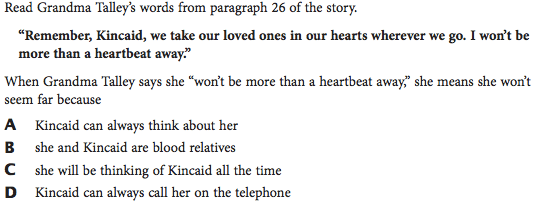With the release last week of half of the test questions from the most recent round of New York State Common Core ELA/Literacy and math tests, we can now begin to see if the tests are, as one New York principal insisted last spring, “confusing, developmentally inappropriate and not well aligned with the Common Core standards.”
Do the charges stick? After a quick analysis of the released items, on the charge of “confusing,” I find the tests (at least somewhat) guilty. Not well aligned with the Common Core standards? Not guilty. Developmentally inappropriate? That charge should never have been brought in the first place.
Calling Common Core “developmentally inappropriate” has become something of a blanket criticism, but it’s largely irrelevant. University of Virginia cognitive scientist Dan Willingham has repeatedly cautioned against invoking the idea of developmental stages to draw strong conclusions about what children are ready for. “Hard” and “developmentally inappropriate” are not synonyms.
Critics are on firmer footing describing some test items as confusing. The first passage on the fifth-grade reading test was “My Grandma Talley,” a short story by Nadine Oduor that makes frequent use of vernacular language. Unfamiliar words like “frettin’,” “lotta” (a lot of), and “doodlebug” and idiomatic language like “wet behind the ears” could easily trip up young readers. Dialect is not the same as the archaic language typically found in historical documents, which have been heavily signaled as important under Common Core.
Following the passage, one question asks students to interpret what the narrator’s grandmother meant when she used a potentially unfamiliar expression:

The answer draws a subtle difference between A (correct) and C (incorrect). Frankly, if a fifth grader in a classroom discussion interpreted the phrase to mean they would be able to think about each other, I wouldn’t think to push for a more precise answer. Most of us also probably associate the phrase “a heartbeat away” with sudden death, as in “the vice president is a heartbeat away from the presidency.” This makes it a poor, confusing choice of expressions on which to base a test question.
Elsewhere on the same test is a passage about BMX bike racing and a section about a boy sailing around the world, which students are asked to evaluate and analyze through the lens of a companion piece about “smart risk-taking.” These are tasks that go far beyond mere recall or making inferences yet are well within what teachers have been led to expect under Common Core.
That said, it would be better—and far more fair—if test writers took care to choose reading passages about subjects children are more likely to have encountered in school.
The most important and powerful breakthrough in Common Core is the standards’ clear guidance that “by reading texts in history/social studies, science, and other disciplines, students build a foundation of knowledge in these fields that will also give them the background to be better readers in all content areas.” If this is what is expected, reading passages ought to encourage and validate good instructional choices.
A third-grade passage about turning tree sap into maple syrup, for example, is more likely to control for background knowledge and draw upon things children study in school (plants and trees) than a passage on the same test about snowshoeing.
It’s unfair and unnecessary to risk confusing children with topics—sailing, BMX racing, snowshoeing—that low-income urban children, in particular, are likely to know little about and have no out-of-school experience with.
Another curious choice: test writers surely do Common Core no favors with an eighth-grade passage asking students to evaluate claims on global warming. Why wave a red flag in front of those who already fear that CCSS means political indoctrination? Also, for those who have broadly misinterpreted Common Core to mean children must close read and cold read everything—no pre-reading for you!—note that one sixth-grade reading passage, a poem about “pit ponies,” explains at the outset that “Ponies and donkeys were once used in mines to pull carts of ore—in the United States as well as Great Britain.”
Math questions are challenging, often requiring multiple operations to answer a single question. A fourth-grade question asks, “In the number 344,586, how many times greater is the value represented by the 4 in the ten thousands place than the value represented by the 4 in the thousands place?” Where previous state tests might have simply asked for the value of a single digit, this requires knowing the value of both and the difference. You can calculate it or simply know that the same digit one place to the left is ten times greater. Either way, it’s far more challenging than simply knowing that the 5, for example, represents 500.
The tests are tough. Too tough? Recall that New York State was the poster child for the “proficiency illusion,” an alarming and dishonest dumbing down of state tests and lower cut scores. It got so bad that Diana Senechal demonstrated that random guessing could reliably earn a passing score. Forgive me if I do not share others’ enthusiasm for a return to those comforting, accomplishment-free days.
The bottom line: the tests are hard, as expected, but the choice of texts needs work. Test makers have an obligation to signal to the field the kind of instructional choices they want teachers to make—an obligation New York’s test makers, in rushing ahead rather than waiting for PARCC, appears not to have considered.
Under Common Core, text selection is critically important for teachers. It should matter even more on the tests.



